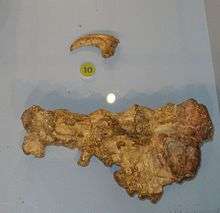Gres de Saint-Chinian
The Gres de Saint-Chinian is a geological formation in Aude and Hérault, France whose strata date back to the Late Cretaceous. Dinosaur remains are among the fossils that have been recovered from the formation.[1]
| Gres de Saint-Chinian Stratigraphic range: Late Campanian - Early Maastrichtian[1] | |
|---|---|
| Type | Geological formation |
| Location | |
| Region | Europe |
| Country | |
Vertebrate paleofauna
Gres de Saint-Chinian outcrops in Département de L'Herault have produced dinosaur eggs, along with the indeterminate remains of avialans, enantiornithes, and possible indeterminate abelisaurids.[1]
| Dinosaurs of the Gres de Saint-Chinian | ||||||
|---|---|---|---|---|---|---|
| Genus | Species | Location | Stratigraphic position | Abundance | Notes | Images |
|
A. atacis[1] |
|
| ||||
|
Rhabdodon cf. priscus[1] |
|
|||||
|
R. septimanicus[1] |
|
"Dentary."[2] |
||||
|
R. lugdunensis[1] |
|
Actually indeterminate Ankylosauria remains.[1] | ||||
|
M. pannoniensis[1] |
|
|||||
|
V. mechinorum[1] |
||||||
gollark: A generally intelligent AI:- could make itself more intelligent much more easily than a human- will probably have a very different set of capabilities to humans even if they "average out" to "equal intelligence" and thus might be really dangerous depending on what they are- is unlikely to share much of our human value system unless explicitly built that way
gollark: That's possibly reasonable but problematic to do.
gollark: Nobody would want AGI if it was just a nice paperweight.
gollark: They could do 3828288382 things, obviously. That's the problem.
gollark: The problem is that people won't agree on whether an AI is "truly intelligent" until it's converting them into paperclips.
See also
- List of dinosaur-bearing rock formations
References
- Weishampel, David B; et al. (2004). "Dinosaur distribution (Late Cretaceous, Europe)." In: Weishampel, David B.; Dodson, Peter; and Osmólska, Halszka (eds.): The Dinosauria, 2nd, Berkeley: University of California Press. Pp. 588-593. ISBN 0-520-24209-2.
- "Table 19.1," in Weishampel, et al. (2004). Page 414.
This article is issued from Wikipedia. The text is licensed under Creative Commons - Attribution - Sharealike. Additional terms may apply for the media files.


